HISTORY OF THE NELSON-CURTIES MICROSCOPES
MAKER: CHARLES BAKER COMPANY
INTRODUCTION:
This webpage documents the microscopes conceived by Edward Miles Nelson and Built by C. L. Curties, who by that time was running the Charles Baker Company. We also touch on the Demonstration and portable microscope built for Nelson by the Powell and Lealand company. The author is indebted to his friends interested in the History of the microscope for their help with information shown on this page, in particular Dr Joseph Zeligs and James Solliday. I am also grateful for the kindness of Dr Jurriaan de Groot, who kindly supplied me with images of his re-creation of the Powell & Lealand Jubilee Microscope.
HISTORY OF THE NELSON-CURTIES-BAKER MICROSCOPES
Charles Baker operated a microscope business from 1851 and he died in 1893. As he got older, his foreman, Charles Lee (C.L.) Curties and his family gradually assumed more responsibility for the business. By the late 1880's Charles Baker had turned much of his business operation over to the Curties family. C. L. Curties, Baker's foreman at the time, was actually the supervisor of new designs, and models with features suggested by E.M. Nelson were designed by C.L. Curties.
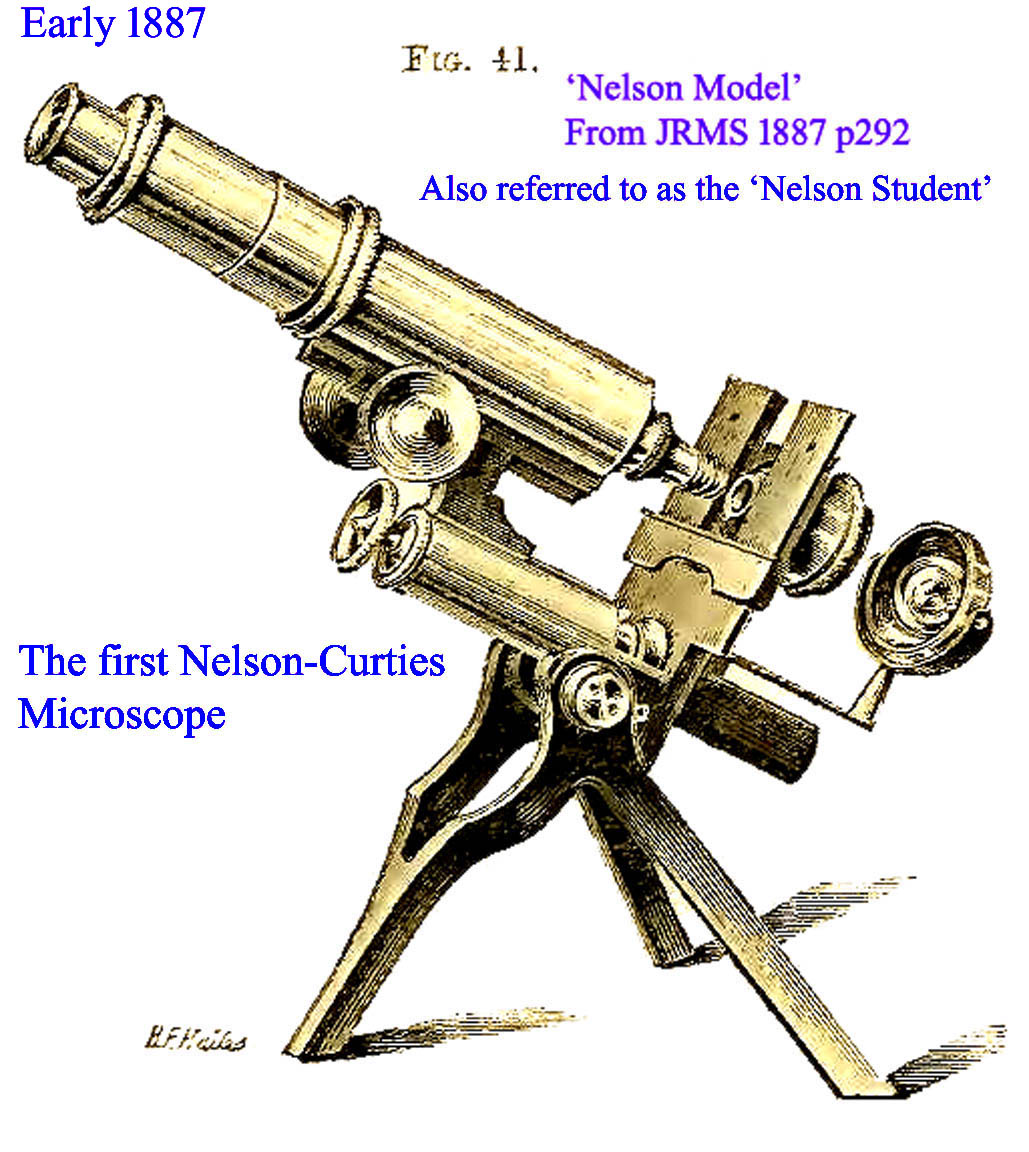
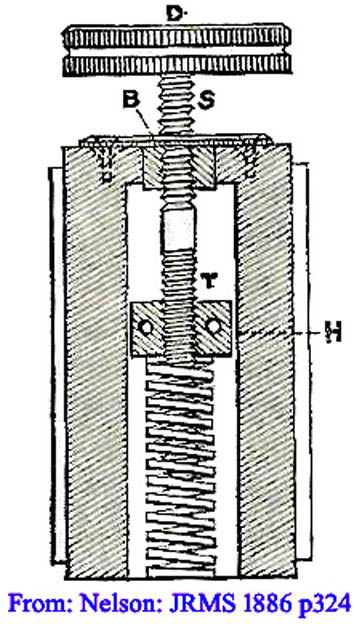 The earliest model reflecting a Nelson-Curties collaboration was a lightweight stand known, (confusingly) as the 'Nelson Model,' first described in early 1887. It was shown to the members of the Quekett Microscopical Club on January 28, 1887 by E.M. Nelson himself. It was also reported by Nelson on page 292 of the JRMS for 1887. This microscope was hailed by Nelson as a great achievement because it was, in his view the first 'Student' microscope that was suitable for high class work, yet was not inordinately expensive. This was achieved in part through the use of a 'Campbell' Differential Screw mechanism for the fine focus. It was called this because the Reverend J. A. Campbell suggested this mechanism for this use, but it was actually invented long before Campbell. This mechanism uses a screw with two different pitches, one finer than the other. The coarser end is threaded through the fixed end of the limb and the finer one drives the focusing mechanism. Because the movement is equal to the difference in the pitches, a very fine and precise movement can be achieved in a structurally strong design. This type of fine adjustment continued to be used in future Nelson stands.
The earliest model reflecting a Nelson-Curties collaboration was a lightweight stand known, (confusingly) as the 'Nelson Model,' first described in early 1887. It was shown to the members of the Quekett Microscopical Club on January 28, 1887 by E.M. Nelson himself. It was also reported by Nelson on page 292 of the JRMS for 1887. This microscope was hailed by Nelson as a great achievement because it was, in his view the first 'Student' microscope that was suitable for high class work, yet was not inordinately expensive. This was achieved in part through the use of a 'Campbell' Differential Screw mechanism for the fine focus. It was called this because the Reverend J. A. Campbell suggested this mechanism for this use, but it was actually invented long before Campbell. This mechanism uses a screw with two different pitches, one finer than the other. The coarser end is threaded through the fixed end of the limb and the finer one drives the focusing mechanism. Because the movement is equal to the difference in the pitches, a very fine and precise movement can be achieved in a structurally strong design. This type of fine adjustment continued to be used in future Nelson stands.
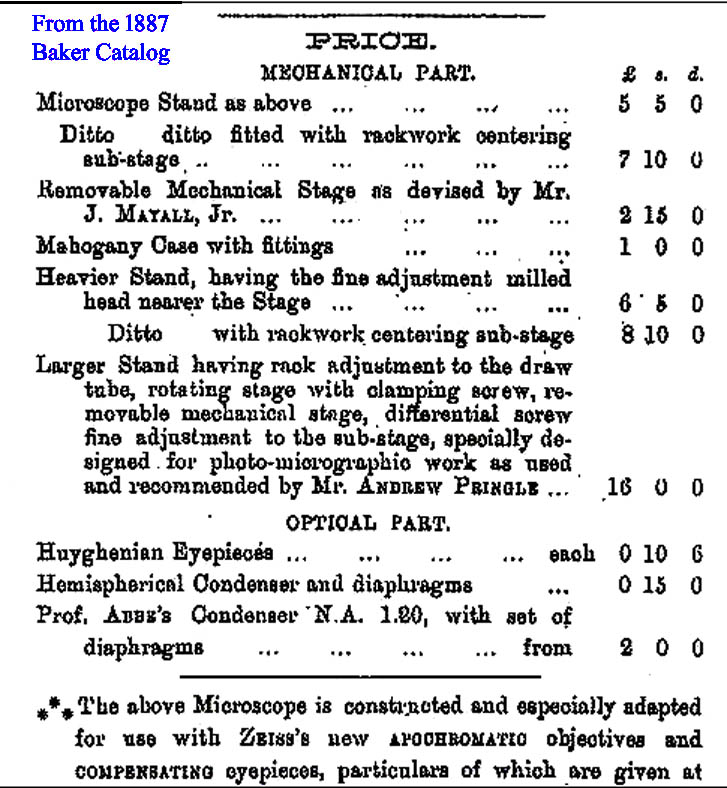 In the 1887 catalog, the original 'Nelson microscope' was the only stand associated with Nelson's name and illustrated. In the price list however, additional features and other stands were listed, though not named. Among the optional features for the first Nelson model were 1)Rackwork and centerable substage, and 2)Removeable Mechanical Stage 'as devised by Mr J. Mayall Jr'. There were however two more stands offered. One was a 'Heavier Stand having the fine adjustment milled head nearer the stage' and with the option of the rackwork/centerable substage. Rackwork to the drawtube was not mentioned on this model. Still bigger was a 'Larger Stand' having rack work to the drawtube, rotating stage with clamping screw, removable mechanical stage, and differential fine adjustment to the substage; this sounds very much like the Nelson No 2, though no image nor specific name is given to this microscope except it being in the prices under the Nelson model, The 'Larger Stand' likely what was illustrated in the 1888 JRMS. As noted below, that later became the Nelson No 2.
In the 1887 catalog, the original 'Nelson microscope' was the only stand associated with Nelson's name and illustrated. In the price list however, additional features and other stands were listed, though not named. Among the optional features for the first Nelson model were 1)Rackwork and centerable substage, and 2)Removeable Mechanical Stage 'as devised by Mr J. Mayall Jr'. There were however two more stands offered. One was a 'Heavier Stand having the fine adjustment milled head nearer the stage' and with the option of the rackwork/centerable substage. Rackwork to the drawtube was not mentioned on this model. Still bigger was a 'Larger Stand' having rack work to the drawtube, rotating stage with clamping screw, removable mechanical stage, and differential fine adjustment to the substage; this sounds very much like the Nelson No 2, though no image nor specific name is given to this microscope except it being in the prices under the Nelson model, The 'Larger Stand' likely what was illustrated in the 1888 JRMS. As noted below, that later became the Nelson No 2.
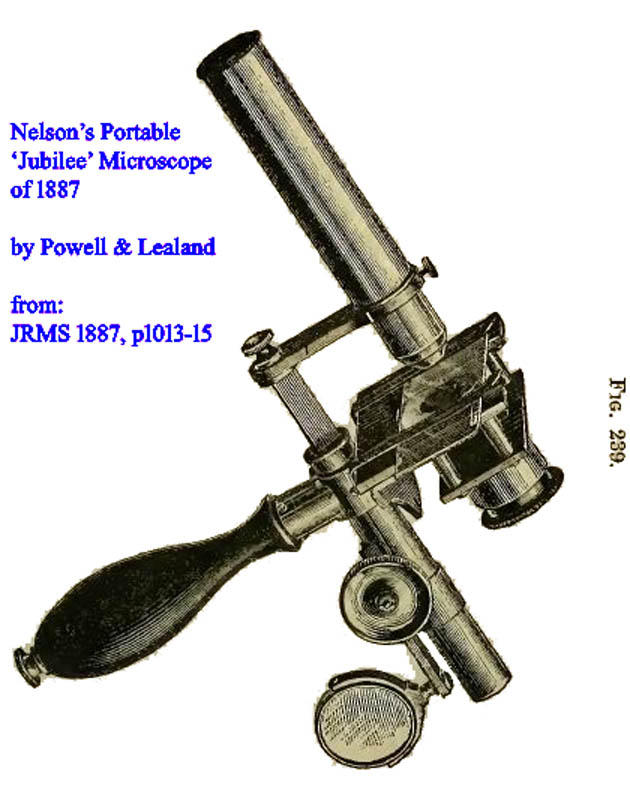 E.M.Nelson was very familiar with all of the microscopical community. After suggesting his first 'Nelson' Model to Curties of Baker, he asked Powell and Lealand to construct a small multi-purpose microscope. It was designed to function both as a basic portable microscope, and a demonstration microscope. In November of 1887 he exhibited this model at a meeting of RMS. It came to be known as the 'Nelson Jubilee Portable Microscope' because 1887 was the Golden Jubilee of Queen Victoria. To date, I know of only two extant examples of this microscope. One example, dated the year of the invention 1887, was given by Nelson himself to Elliot Merlin and donated to the RMS collection. Another, dated 1889, was donated by T.H.Court to the Science museum in London. To date we have found no advertisement or P & L catalog listing for the Jubilee microscope. Dr Jurriaan de Groot has recently created a very nice facsimile of the Jubilee microscope which, through his kindness, is also featured on this site.
E.M.Nelson was very familiar with all of the microscopical community. After suggesting his first 'Nelson' Model to Curties of Baker, he asked Powell and Lealand to construct a small multi-purpose microscope. It was designed to function both as a basic portable microscope, and a demonstration microscope. In November of 1887 he exhibited this model at a meeting of RMS. It came to be known as the 'Nelson Jubilee Portable Microscope' because 1887 was the Golden Jubilee of Queen Victoria. To date, I know of only two extant examples of this microscope. One example, dated the year of the invention 1887, was given by Nelson himself to Elliot Merlin and donated to the RMS collection. Another, dated 1889, was donated by T.H.Court to the Science museum in London. To date we have found no advertisement or P & L catalog listing for the Jubilee microscope. Dr Jurriaan de Groot has recently created a very nice facsimile of the Jubilee microscope which, through his kindness, is also featured on this site.
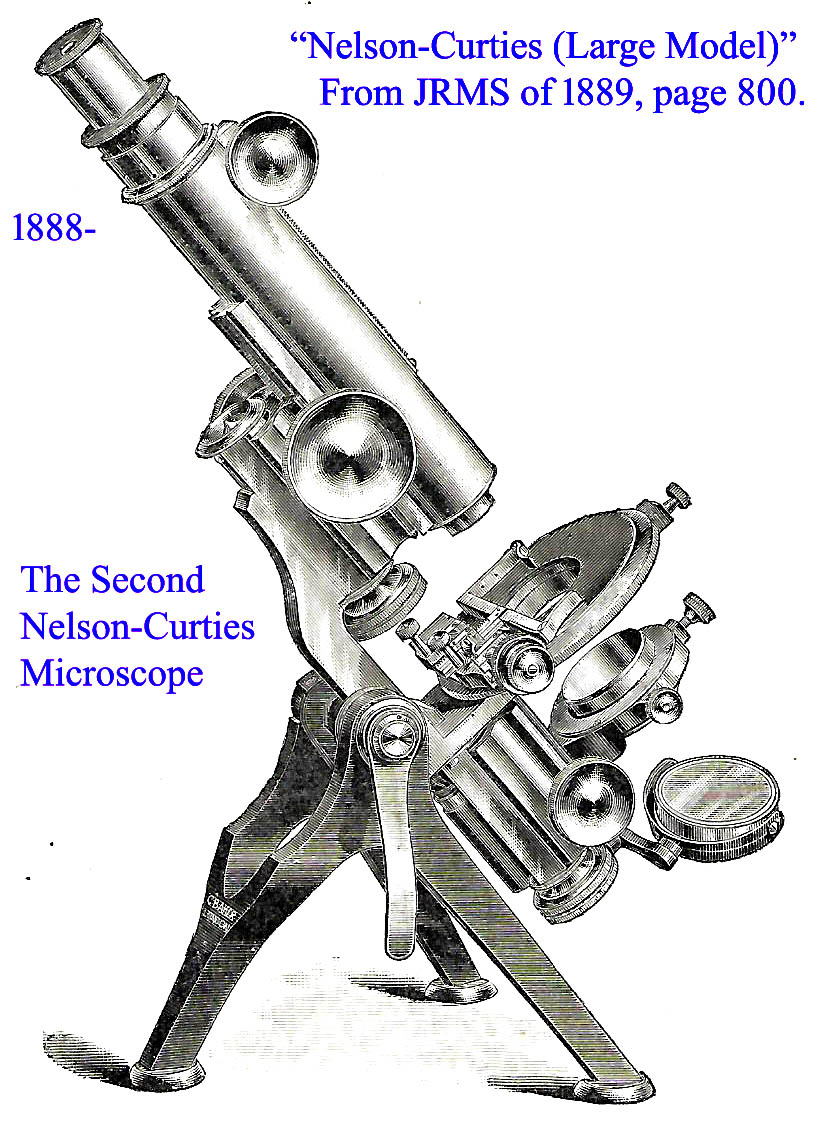 The next year, in 1888, the first versions of what then came to be known as the 'Nelson' Microscope were described. This stand, later to be called the 'Nelson-Curties No. 2', or simply the 'Nelson Model', was, for a short time, the 'No. 1' stand for the Baker company. This early version of the No. 2. was referred to in the JRMS as the 'Nelson-Curties (Large Model)'. In modern times, this stand is often called the 'Nelson-Baker' to differentiate it from stands made by other makers and associated with Nelson's name, though Baker himself had little to do with the business by this time and it was Curties who supervised its construction. One of the important features of this microscope was the presence two fine focus controls, one for focusing the tube and the other for focusing the substage. This feature is needed if one is going to use Nelsonian Illumination, also called Critical Illumination.
It was first reported only in written form in the JRMS of 1888 on page 691 and was subsequently first pictured in the JRMS of 1889 page 801. The microscope, as pictured in the 1889 JRMS differed from the later number 2 in the following ways. First, it had a concentric controlled mechanical stage instead of the two separate controls. Many later versions had two separate controls for movement as seen in the later No 2 and even some No 1 microscopes. Secondly, it had round foot pads (toe-pads) without slots(to be added in later models), and third, the substage fine adjustment was initially standard rather than an option as it was later. Fine adjustment both above and below the stage used the 'Campbell Differential Screw' mechanism as noted above.
The next year, in 1888, the first versions of what then came to be known as the 'Nelson' Microscope were described. This stand, later to be called the 'Nelson-Curties No. 2', or simply the 'Nelson Model', was, for a short time, the 'No. 1' stand for the Baker company. This early version of the No. 2. was referred to in the JRMS as the 'Nelson-Curties (Large Model)'. In modern times, this stand is often called the 'Nelson-Baker' to differentiate it from stands made by other makers and associated with Nelson's name, though Baker himself had little to do with the business by this time and it was Curties who supervised its construction. One of the important features of this microscope was the presence two fine focus controls, one for focusing the tube and the other for focusing the substage. This feature is needed if one is going to use Nelsonian Illumination, also called Critical Illumination.
It was first reported only in written form in the JRMS of 1888 on page 691 and was subsequently first pictured in the JRMS of 1889 page 801. The microscope, as pictured in the 1889 JRMS differed from the later number 2 in the following ways. First, it had a concentric controlled mechanical stage instead of the two separate controls. Many later versions had two separate controls for movement as seen in the later No 2 and even some No 1 microscopes. Secondly, it had round foot pads (toe-pads) without slots(to be added in later models), and third, the substage fine adjustment was initially standard rather than an option as it was later. Fine adjustment both above and below the stage used the 'Campbell Differential Screw' mechanism as noted above.
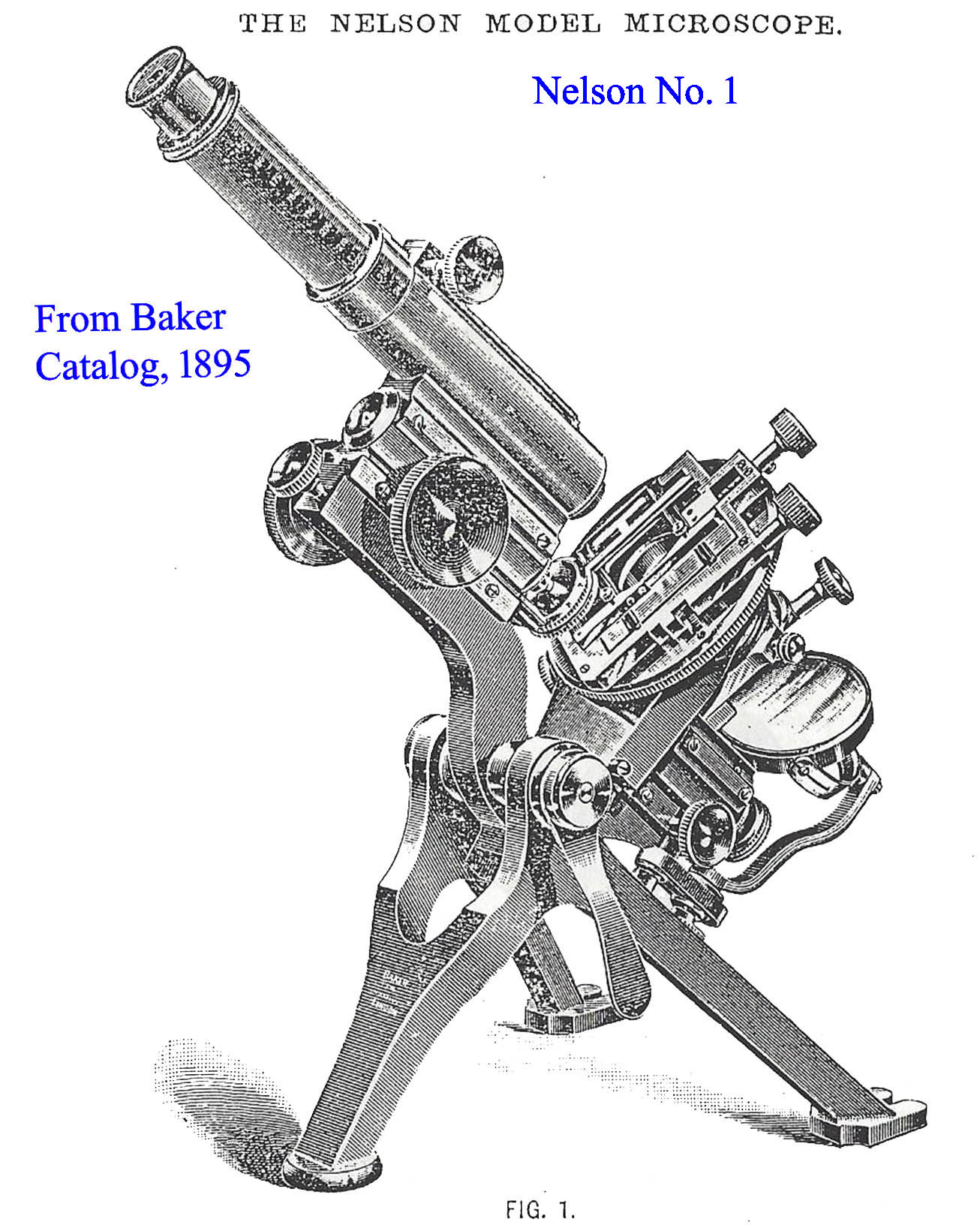 By 1892 a larger version, the 'New Microscope' or 'Nelson Model No. 1A,' a larger version of the Nelson-Curties design, became the 'No. 1' Stand, and the original Nelson-Curties became the No 2. The No. 1 stand was usually shown in illustrations to have a rack and pinion rotation to both the stage and substage. The mirror support was double jointed, and the substage fine focus was standard. The 1895 No 1 was pictured in the catalog with two separate controls for the mechanical stage, but some later illustrations show concentric controls.
The stand was referred to as No 1A or 1a when the Turrell-type concentric control type stage was used and simply the No 1 when the X and Y motions were controlled separately. Most importantly, this was a much thicker and heavier stand. Unlike earlier versions, now called the No 2's, the limb of the new No. 1 bends outward, away from the inclination joint, whereas the limb curves inward at its top end on the No. 2's. In late models of the Nelson No 1, the substage fine focus was no longer a standard feature, similar to what happened with the number 2. (see below). The splay of the foot on the huge number 1 was noted in the catalog to be 11 x 9 inches (compared to 7 x 7.5 inches for the No 2).
By 1892 a larger version, the 'New Microscope' or 'Nelson Model No. 1A,' a larger version of the Nelson-Curties design, became the 'No. 1' Stand, and the original Nelson-Curties became the No 2. The No. 1 stand was usually shown in illustrations to have a rack and pinion rotation to both the stage and substage. The mirror support was double jointed, and the substage fine focus was standard. The 1895 No 1 was pictured in the catalog with two separate controls for the mechanical stage, but some later illustrations show concentric controls.
The stand was referred to as No 1A or 1a when the Turrell-type concentric control type stage was used and simply the No 1 when the X and Y motions were controlled separately. Most importantly, this was a much thicker and heavier stand. Unlike earlier versions, now called the No 2's, the limb of the new No. 1 bends outward, away from the inclination joint, whereas the limb curves inward at its top end on the No. 2's. In late models of the Nelson No 1, the substage fine focus was no longer a standard feature, similar to what happened with the number 2. (see below). The splay of the foot on the huge number 1 was noted in the catalog to be 11 x 9 inches (compared to 7 x 7.5 inches for the No 2).
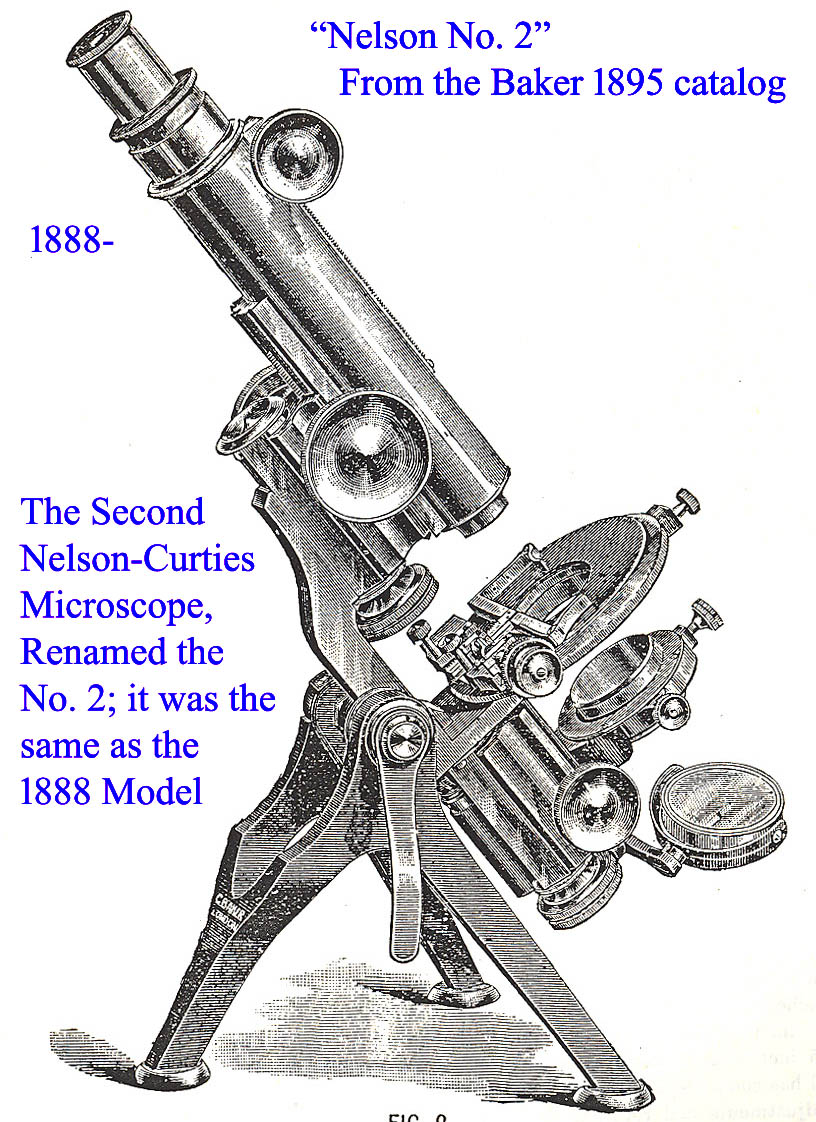
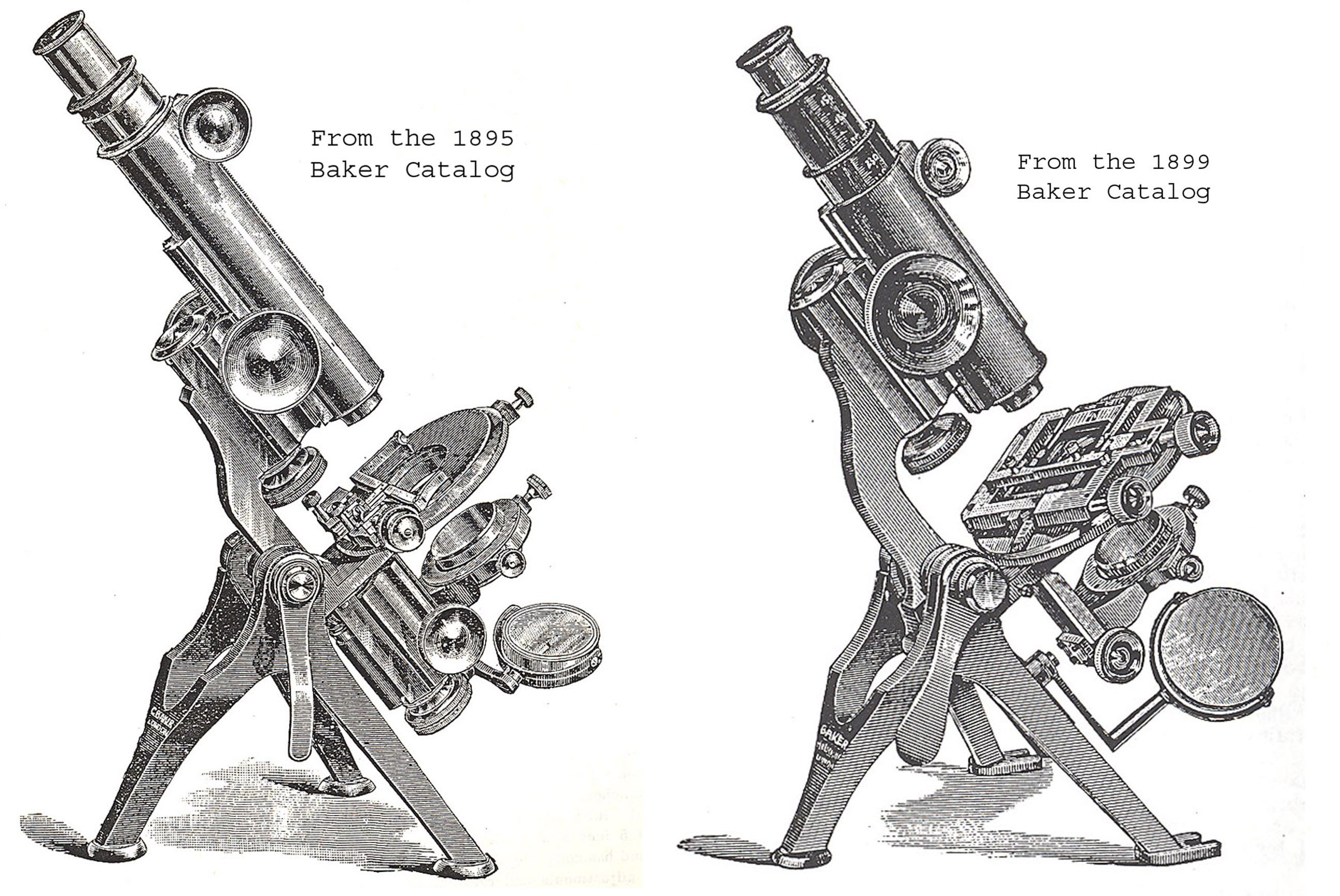 Once the new larger and stouter No. 1 was released, the original model became the No. 2. As can be seen here to the left, the original 'Large Model' and what was later called the No 2 were identical, at least initially. As time went on though, some features were changed or became optional. One of the unusual, if not distinctive, features of some of these microscopes, as noted above, was the fine adjustment to the substage. This feature was provided routinely on the No. 2 only until 1895, when it became optional. These and other changes, including the change to slotted feet and non-concentric controls for the mechanical stage are reflected in the differences in the catalog engravings for the Nelson No. 2 as shown to the right. The substage fine focus being optional is similar to the Watson practice of also making their substage fine focus optional on some Van Heurk models and also for their Royal Model.
Once the new larger and stouter No. 1 was released, the original model became the No. 2. As can be seen here to the left, the original 'Large Model' and what was later called the No 2 were identical, at least initially. As time went on though, some features were changed or became optional. One of the unusual, if not distinctive, features of some of these microscopes, as noted above, was the fine adjustment to the substage. This feature was provided routinely on the No. 2 only until 1895, when it became optional. These and other changes, including the change to slotted feet and non-concentric controls for the mechanical stage are reflected in the differences in the catalog engravings for the Nelson No. 2 as shown to the right. The substage fine focus being optional is similar to the Watson practice of also making their substage fine focus optional on some Van Heurk models and also for their Royal Model.
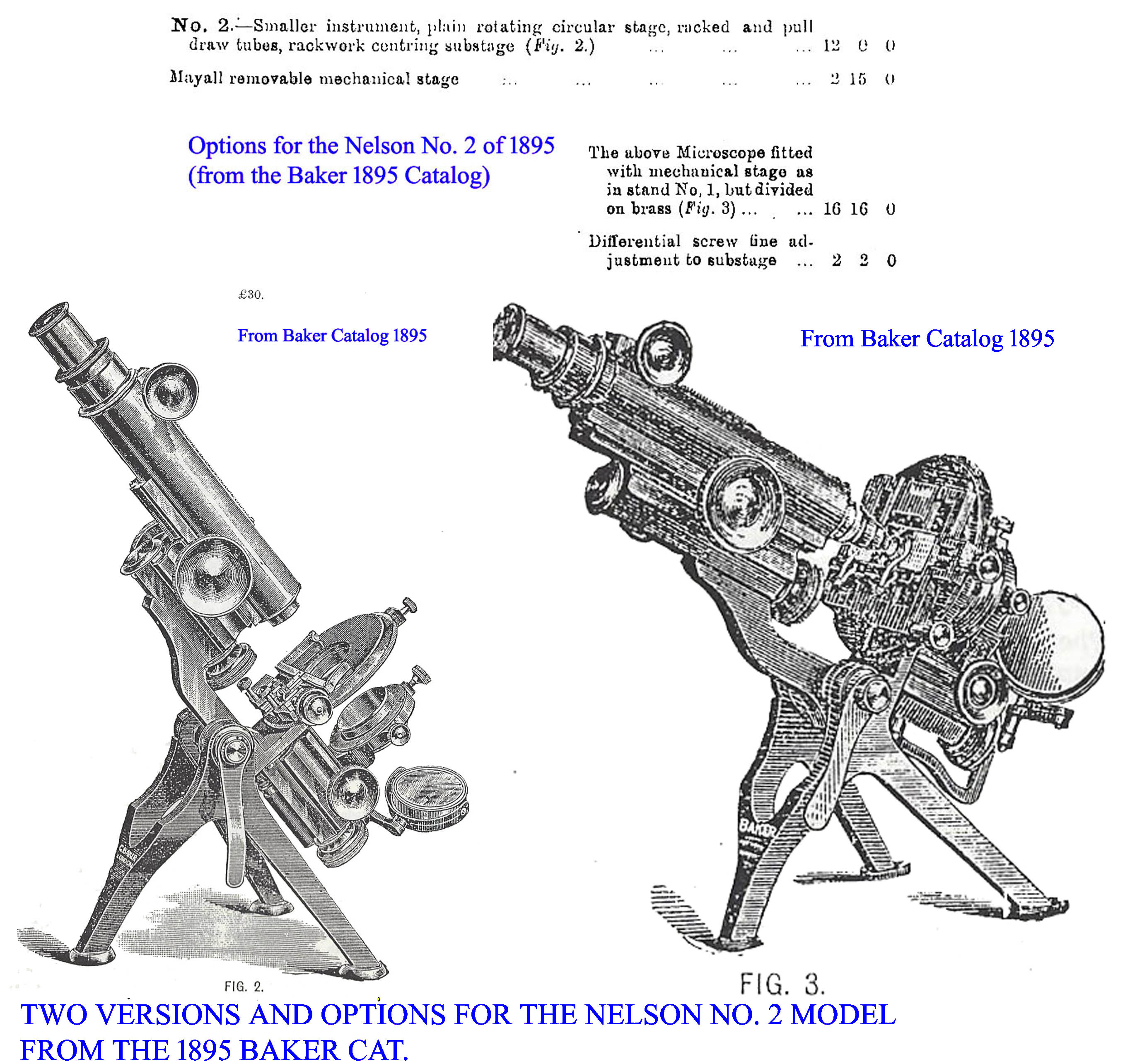
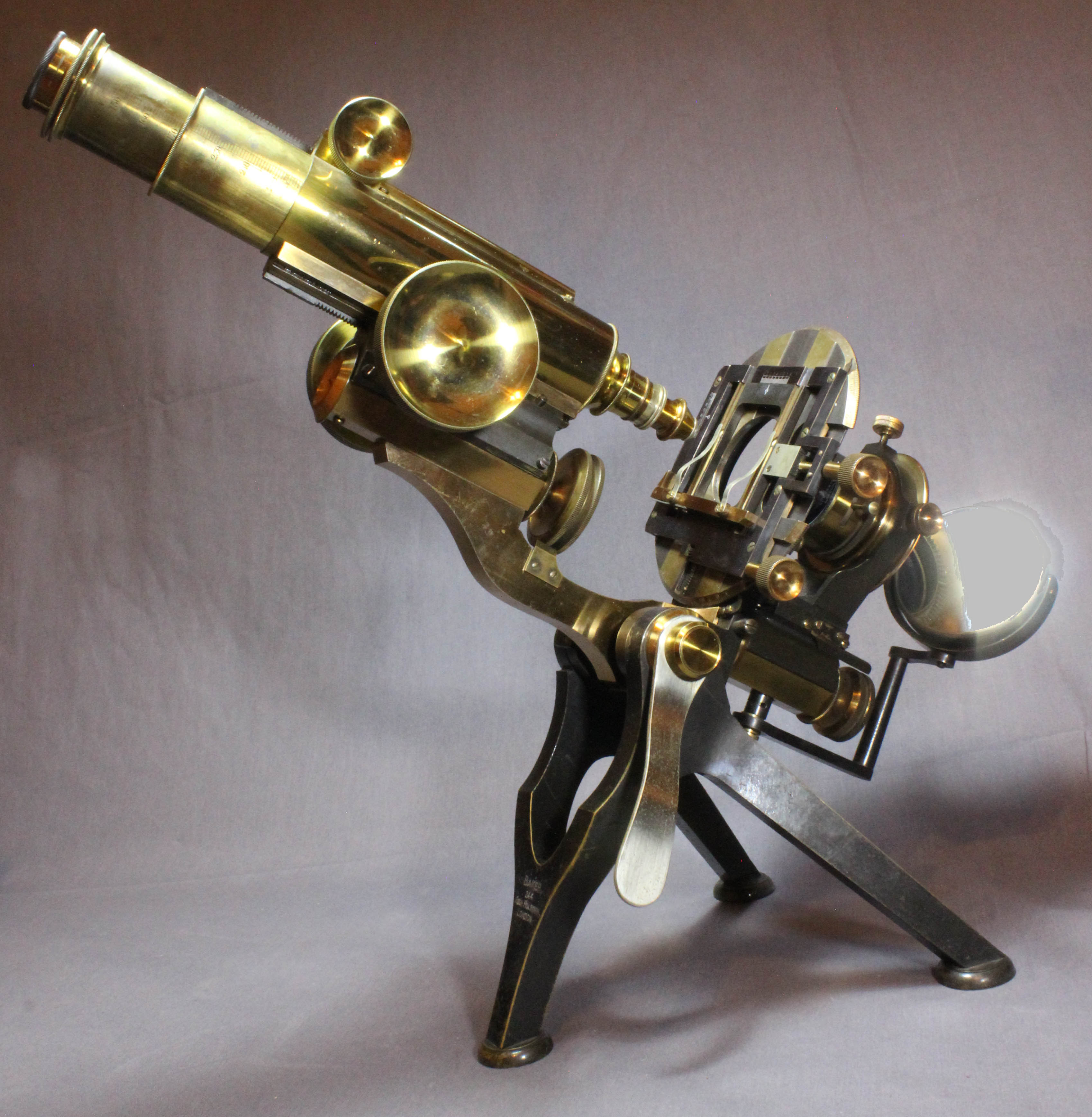 In 1895 two different examples of the Nelson No. 2 were offered. The basic model, seen to the left of the engraving, cost £12. This basic model had a dual controlled type mechanical stage, (confusingly pictured on the more expensive stand to the right in the engraving), and a rack and pinion driven rotating and centering substage. For an extra £2 15, the 'Mayall removable mechanical stage' was substituted. The Mayall stage is actually pictured on the engraving, to the left, even though it was not standard for that model. For £16 16, the dual control mechanical stage as on the number 2 was supplied with the addition of engraved divisions. This was not a Mayall type stage however. For both number 2's the fine adjustment to the substage continued to be optional, and cost an extra £2 2. That would bring the total cost of the No 2 with all the options up to £18 18. An example of the more expensive No 2 with the additional and optional features of silvered graduated rotation to the (not Mayall)stage, and fine adjustment to the substage, complete with the rack and pinion driven substage rotation is shown to the right. This model also has its scales for slide location engraved on oxidized brass rather than nickel as in the later number 2 on this site. Its round front foot-pad (toes) of the tripod foot not being slotted, support the notion that this is a relatively early model, certainly before 1896 when the front two foot pads (toes) of the stand became routinely slotted. Its features strongly resemble the original stand of 1889 as pictured in the JRMS, but with the addition of geared rotation to the substage, the calibrated stage rotation, and the stouter two-control mechanical stage. Instead of two bars to hold the slide, this stage has two stage clips protruding from a single bottom bar, just like the stand in the right side of the engraving. It almost certainly dates to about 1895. Rotation for the substage by rack and pinion was discontinued for the number two starting in 1898.
In 1895 two different examples of the Nelson No. 2 were offered. The basic model, seen to the left of the engraving, cost £12. This basic model had a dual controlled type mechanical stage, (confusingly pictured on the more expensive stand to the right in the engraving), and a rack and pinion driven rotating and centering substage. For an extra £2 15, the 'Mayall removable mechanical stage' was substituted. The Mayall stage is actually pictured on the engraving, to the left, even though it was not standard for that model. For £16 16, the dual control mechanical stage as on the number 2 was supplied with the addition of engraved divisions. This was not a Mayall type stage however. For both number 2's the fine adjustment to the substage continued to be optional, and cost an extra £2 2. That would bring the total cost of the No 2 with all the options up to £18 18. An example of the more expensive No 2 with the additional and optional features of silvered graduated rotation to the (not Mayall)stage, and fine adjustment to the substage, complete with the rack and pinion driven substage rotation is shown to the right. This model also has its scales for slide location engraved on oxidized brass rather than nickel as in the later number 2 on this site. Its round front foot-pad (toes) of the tripod foot not being slotted, support the notion that this is a relatively early model, certainly before 1896 when the front two foot pads (toes) of the stand became routinely slotted. Its features strongly resemble the original stand of 1889 as pictured in the JRMS, but with the addition of geared rotation to the substage, the calibrated stage rotation, and the stouter two-control mechanical stage. Instead of two bars to hold the slide, this stage has two stage clips protruding from a single bottom bar, just like the stand in the right side of the engraving. It almost certainly dates to about 1895. Rotation for the substage by rack and pinion was discontinued for the number two starting in 1898.
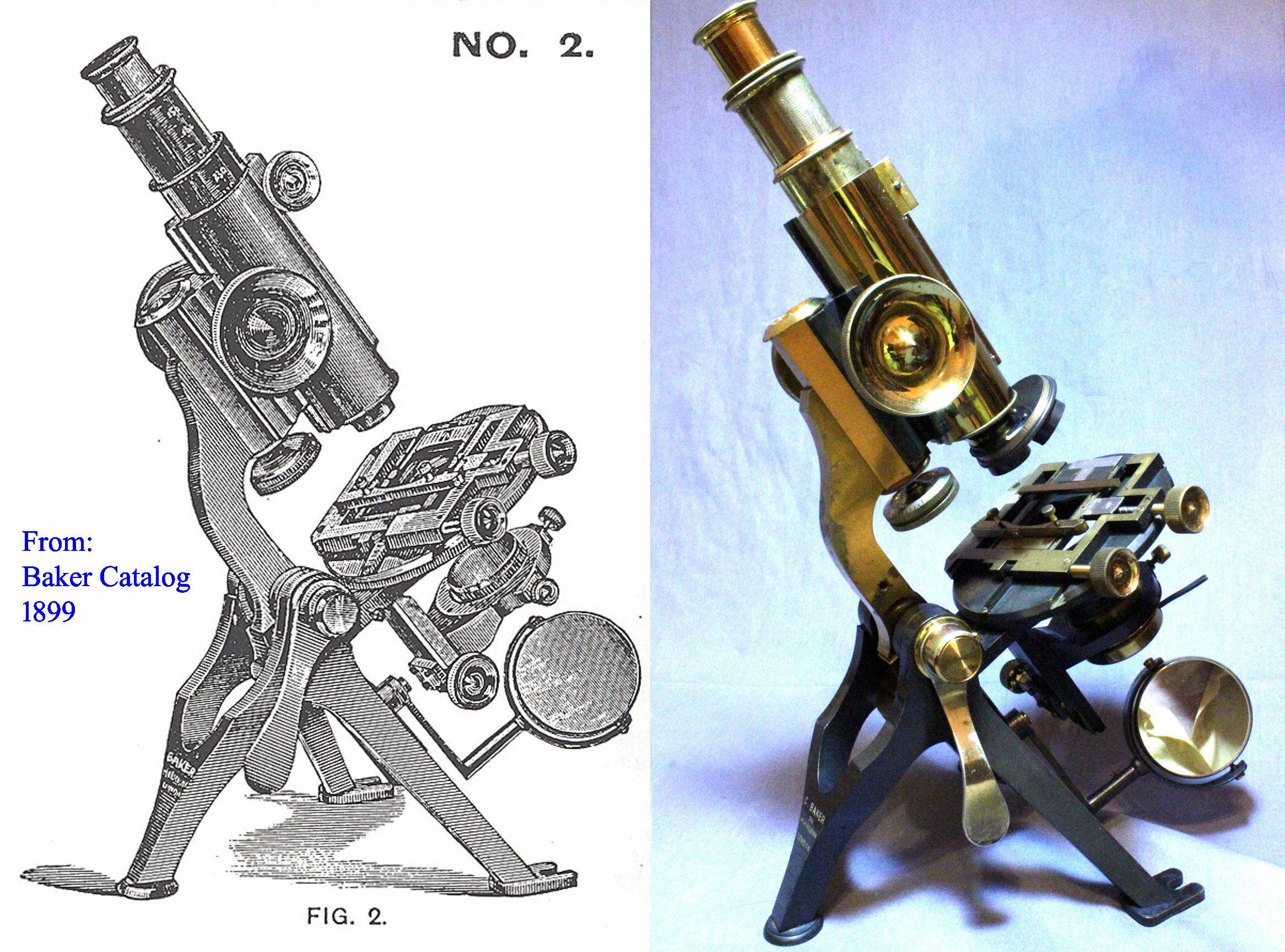 Shown here is a later version of the Nelson-Curties No 2, as as shown in the 1899 catalog. It now included the stage with separate X and Y controls standard, and slotted front feet for anchoring. The rack and pinion rotation to the substage, and the substage fine focus are no longer standard features, and not found on this example. Rotation for the substage of the No 2 was no longer offered in the catalogs starting in 1898.
Shown here is a later version of the Nelson-Curties No 2, as as shown in the 1899 catalog. It now included the stage with separate X and Y controls standard, and slotted front feet for anchoring. The rack and pinion rotation to the substage, and the substage fine focus are no longer standard features, and not found on this example. Rotation for the substage of the No 2 was no longer offered in the catalogs starting in 1898.
For most users of the Nelson-Curties model, the number 2, was the usual instrument, and it is a much more commonly seen stand. The Nelson No. 1 is far less common.
Thanks to Dr Joe Zeligs, the author is aware of three examples of the larger Nelson model. This includes the example in this collection, another one selling at the Arthur Frank collection auction at Sotheby's on March 25, 1986, and another selling on Ebay in July 2007. The example of the Nelson-Curties No 1 from the Frank Collection had a concentric control for the mechanical stage and also had a substage fine focus. The example from Ebay in 2007, had separate controls for the mechanical stage and no substage fine focus. Besides the one in this collection these are the only two other examples of the Nelson-Curties No 1 microscope we are aware of. No example of the Nelson-Curties No 1 is to be found in the Golub collection, the RMS collection, the Science Museum of London, the Billings Collection, The Smithsonian, the Moody collection or any other public collection we are aware of. Even the Nelson-Curties No 2 is missing from most public collections.
One of the hallmarks of these Nelson microscopes is the underarm location for the fine focus. This is a feature not offered on the Watson Van Heurk and Royal microscopes.
It should be noted however that on rare occasions, the Nelson-Curties design was supplied (apparently by special request) with a fine focus on top of the arm and at least one example fitted this way does exist in a private collection, and is known to the author.
Early Models had round feet but later, around 1895, they were often provided, as an option, with slotted feet in the front to allow securing the stand to a surface, such as would be used for photography. Slotted feet became standard on the No 2 starting in 1896. The cap on the top of the limb of these microscopes could be removed to allow a third anchor point for the microscope when in the horizontal position for photography.
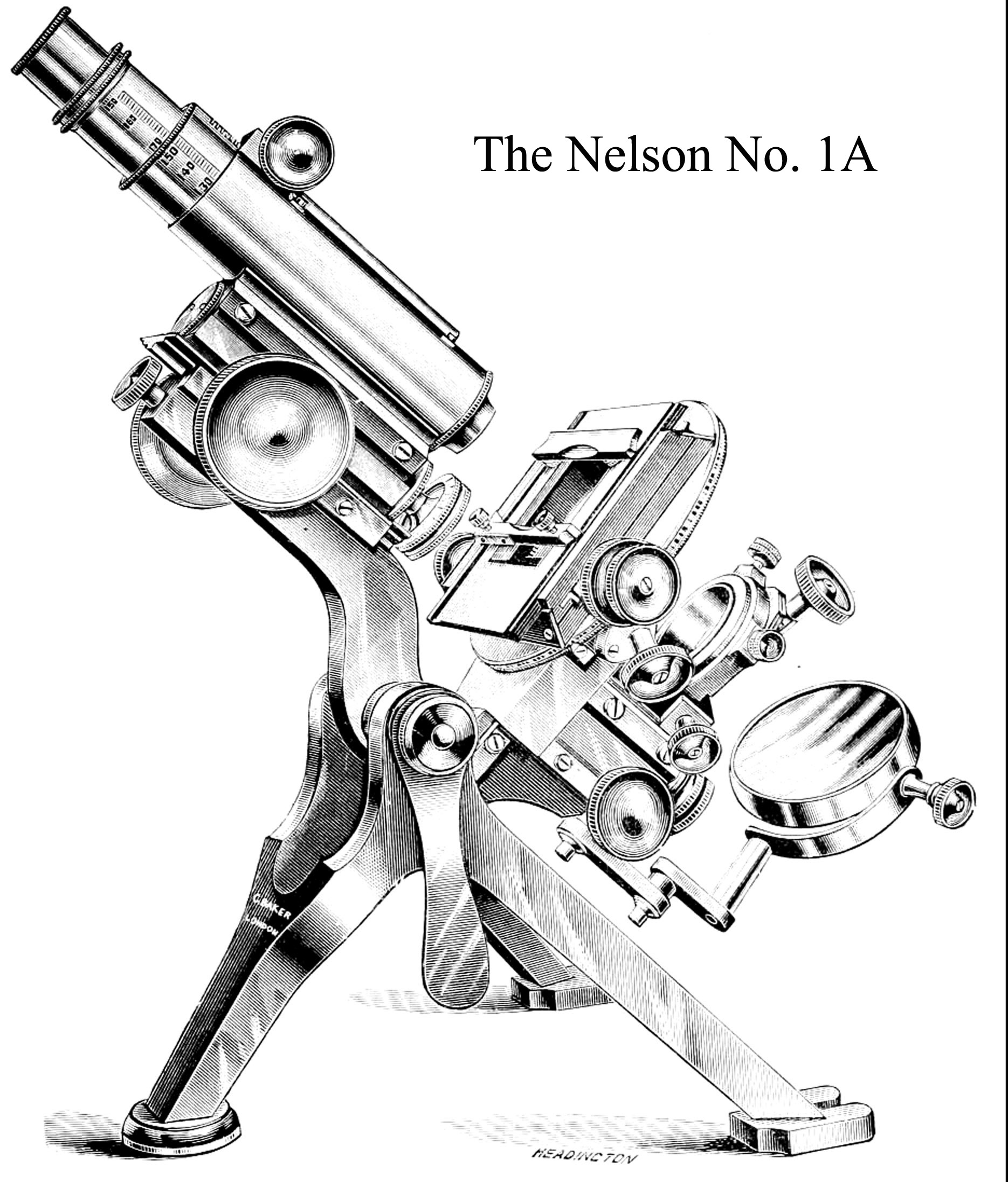 Although the mechanical stage can be rotated manually in both the No. 1 (and 1a), and No. 2, only the No. 1 had the addition of a rack and pinion for this stage rotation. As can be seen above, the rack and pinion rotation to the substage was standard in 1895 but is not clearly shown pictured on any No 2 in any engraving I could find. The features of the Nelson 1A, or 1a, as illustrated in the 1901 edition of Carpenter can be seen in the engraving pictured here.
Although the mechanical stage can be rotated manually in both the No. 1 (and 1a), and No. 2, only the No. 1 had the addition of a rack and pinion for this stage rotation. As can be seen above, the rack and pinion rotation to the substage was standard in 1895 but is not clearly shown pictured on any No 2 in any engraving I could find. The features of the Nelson 1A, or 1a, as illustrated in the 1901 edition of Carpenter can be seen in the engraving pictured here.
It is interesting to compare this stand to the competing stands of the time. The triangular tripod support system is similar to the Powell & Lealand as well as the Watson stands like the No 1. Van Huerk and the Royal Models. In fact, the stand very much resembles the Watson No. 1 'Van Heurck' Models. One difference is the suspension of the microscope on a stirrup-like fitting. It should be noted that a bright lacquered finish for the entire instrument was also available at extra cost from both Watson and Baker. In the 1900 to 1901 catalog, the Nelson No 1 was offered with a bright lacquered brass finish standard. Both the example of The No 1 which sold in 2007 on Ebay, and the example in this collection have an all-bright lacquered finish, but the one sold on Ebay in 2007 being a late example, had no fine focus for the substage.
Both the Watson and the Baker instruments also have rack and pinion adjustment to the drawtube (as does the Royal). Even the provision of a lever to tighten the inclination
joint was also supplied on the No 1. Van Heurk. The mechanical stage of the Nelson-Curties-Baker No. 2 model can rotate, a feature found on the Watson No 1 Van Heurk, Circuit Stage Van Heurck, and the Grand Van Heurck, but not the Royal. Like the Royal, and some Van Heurks, a substage fine-focus was an option for this microscope. The mechanical stage of the Nelson has divisions for the X and Y axis, a feature optional on both the Van Heurk's and Royal. For a side by side comparison
of the Nelson No. 2 and the Royal see here.
One of the most obvious differences between the high-end Watson microscopes and those of Baker, is of course the underarm location of the fine focusing
control, and where present, the location of the substage fine fousing control at the bottom of the substage stem. Locating this control in these places puts much less strain on the instrument than the traditional upper position (like on Watson) and when the main fine focus is controlled by a pulley, as in photography, is much less likely to disturb the stand during focusing than an above-the-arm fine focus. It is also closer to the table and allows the user to rest their hand on the tripod
or table when adjusting the fine focus; this is much easier to control and less likely to cause vibration than the higher location on most microscopes of
the time. In fact, this idea eventually led to a lower position for most of the controls of modern microscopes. A beneath the arm location for the fine focus
is also a feature of the American Acme No. 4 and most Krugelstein microscopes, also in this collection. The size of the Nelson No 2 stand, quite large, is only slightly smaller than the No 1. Van Heurk and the Royal. When side by side the Royal looks much larger, in part due to the larger diameter of the
optical tube on the Watson microscopes of the time, and in part due to the fact that the arm of the Watson microscope was attached in a lower location than the Nelson, thereby raising the rest of the microscope higher above the trunions. The splay of the foot of the Nelson No 2 is seven inches(edge to edge),
while the Royal is slightly less than seven, and the Van Heurk No 1. reportedly seven and three quarters. The outermost tubes of the Van Heurk and Royal are two inches in diameter, while the Nelson is one and a half inches in diameter. All three have a second drawtube that pulls out of the one driven by rack and pinion. All three have the same calibration of both draw tubes. It is obvious that this was E.M. Nelson's (and the Baker company's) response to the Royal and Van Heurk models by Watsons. The Nelson No 1 or 'New Microscope' was even larger than the No 1. Van Heurk.
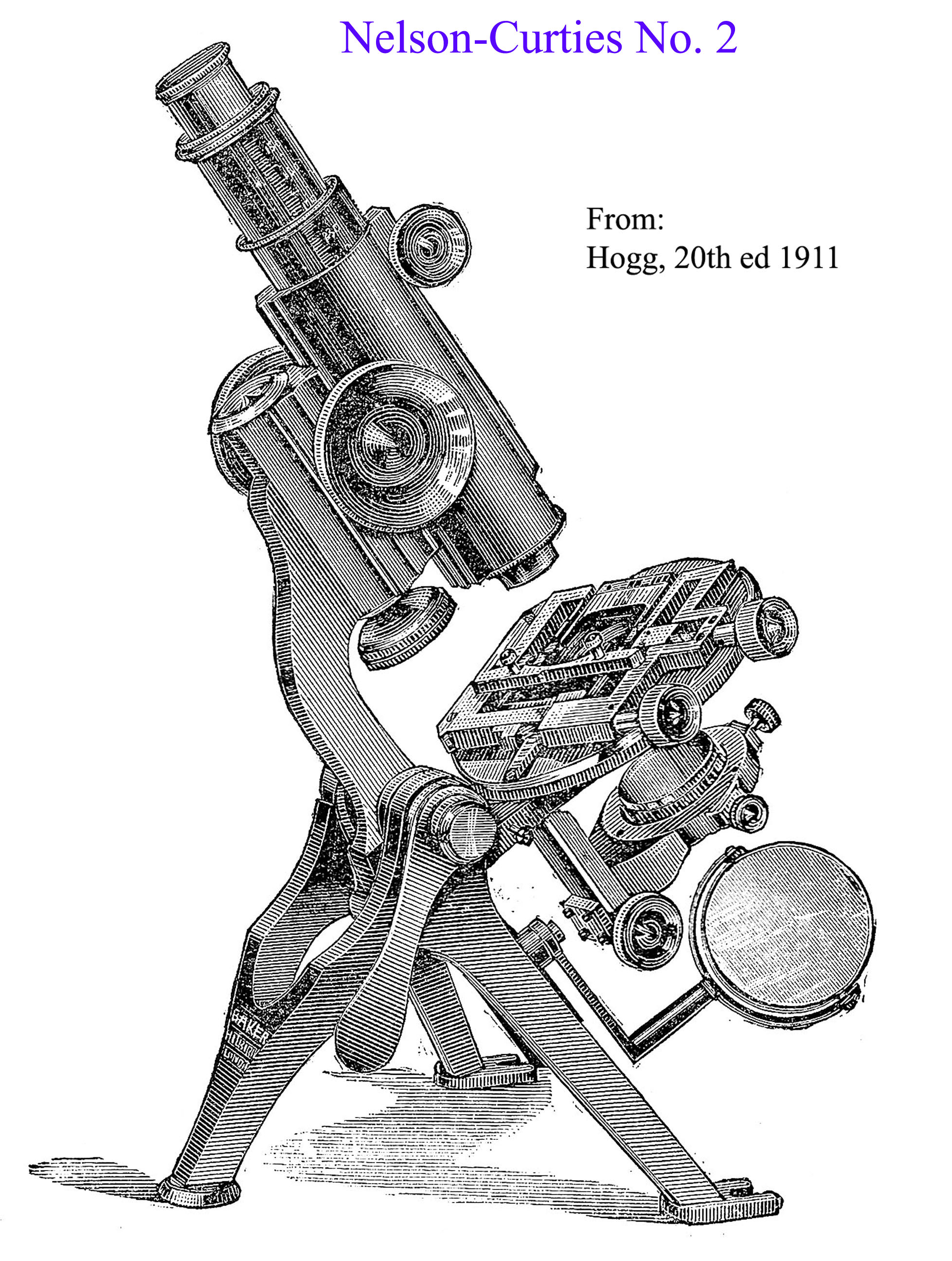 By 1907, the Nelson-Curties models were no longer listed as available in the Baker catalog, although the 1911 edition of Hogg (engraving on left), still pictured and recommended this microscope, and the Nelson No. 1 was featured in the Optical Convention Catalog of 1912, though no mention was made of the number 2.
Thanks to Dr Joe Zeligs I was able to review the pricing of the Nelson No 1 and No 2 about the year 1900. At that time the No 1 was about 30 £ and the No 2 about 16 £. This is very similar to the price for the Watson Royal, also about 16 £; the Watson Van Heurk exhibition model was a bit more at about 37 £. All these prices are approximate and include a single eyepiece and no objectives.
By 1907, the Nelson-Curties models were no longer listed as available in the Baker catalog, although the 1911 edition of Hogg (engraving on left), still pictured and recommended this microscope, and the Nelson No. 1 was featured in the Optical Convention Catalog of 1912, though no mention was made of the number 2.
Thanks to Dr Joe Zeligs I was able to review the pricing of the Nelson No 1 and No 2 about the year 1900. At that time the No 1 was about 30 £ and the No 2 about 16 £. This is very similar to the price for the Watson Royal, also about 16 £; the Watson Van Heurk exhibition model was a bit more at about 37 £. All these prices are approximate and include a single eyepiece and no objectives.
The author is greatful for the assistance of James D Solliday, President of the Microscopical Society of Southern California for supplying some of the information found here.
I am also indebted to Dr Joe Zeligs for supplying information on the examples of the Nelson No. 1 sold at auction recently, as well as catalog prices from the year 1900 and much additional illustrative material and references. A page devoted to the Nelson No 1a discusses the history of the Nelson No 1 model in more depth and also, with the help of Dr Jurriaan de Groot, explains what happened after the Baker company stopped offering Nelson models in their catalog.
For a discussion of the 19th and early 20th century microscopes made by the Charles Baker company, please see the following article:
Solliday, James D. : Charles Baker: His Contributions to Microscopy. Quekett J. Microscopy: vol 37, pp633-646, 1996.

 The earliest model reflecting a Nelson-Curties collaboration was a lightweight stand known, (confusingly) as the 'Nelson Model,' first described in early 1887. It was shown to the members of the Quekett Microscopical Club on January 28, 1887 by E.M. Nelson himself. It was also reported by Nelson on page 292 of the JRMS for 1887. This microscope was hailed by Nelson as a great achievement because it was, in his view the first 'Student' microscope that was suitable for high class work, yet was not inordinately expensive. This was achieved in part through the use of a 'Campbell' Differential Screw mechanism for the fine focus. It was called this because the Reverend J. A. Campbell suggested this mechanism for this use, but it was actually invented long before Campbell. This mechanism uses a screw with two different pitches, one finer than the other. The coarser end is threaded through the fixed end of the limb and the finer one drives the focusing mechanism. Because the movement is equal to the difference in the pitches, a very fine and precise movement can be achieved in a structurally strong design. This type of fine adjustment continued to be used in future Nelson stands.
The earliest model reflecting a Nelson-Curties collaboration was a lightweight stand known, (confusingly) as the 'Nelson Model,' first described in early 1887. It was shown to the members of the Quekett Microscopical Club on January 28, 1887 by E.M. Nelson himself. It was also reported by Nelson on page 292 of the JRMS for 1887. This microscope was hailed by Nelson as a great achievement because it was, in his view the first 'Student' microscope that was suitable for high class work, yet was not inordinately expensive. This was achieved in part through the use of a 'Campbell' Differential Screw mechanism for the fine focus. It was called this because the Reverend J. A. Campbell suggested this mechanism for this use, but it was actually invented long before Campbell. This mechanism uses a screw with two different pitches, one finer than the other. The coarser end is threaded through the fixed end of the limb and the finer one drives the focusing mechanism. Because the movement is equal to the difference in the pitches, a very fine and precise movement can be achieved in a structurally strong design. This type of fine adjustment continued to be used in future Nelson stands.  In the 1887 catalog, the original 'Nelson microscope' was the only stand associated with Nelson's name and illustrated. In the price list however, additional features and other stands were listed, though not named. Among the optional features for the first Nelson model were 1)Rackwork and centerable substage, and 2)Removeable Mechanical Stage 'as devised by Mr J. Mayall Jr'. There were however two more stands offered. One was a 'Heavier Stand having the fine adjustment milled head nearer the stage' and with the option of the rackwork/centerable substage. Rackwork to the drawtube was not mentioned on this model. Still bigger was a 'Larger Stand' having rack work to the drawtube, rotating stage with clamping screw, removable mechanical stage, and differential fine adjustment to the substage; this sounds very much like the Nelson No 2, though no image nor specific name is given to this microscope except it being in the prices under the Nelson model, The 'Larger Stand' likely what was illustrated in the 1888 JRMS. As noted below, that later became the Nelson No 2.
In the 1887 catalog, the original 'Nelson microscope' was the only stand associated with Nelson's name and illustrated. In the price list however, additional features and other stands were listed, though not named. Among the optional features for the first Nelson model were 1)Rackwork and centerable substage, and 2)Removeable Mechanical Stage 'as devised by Mr J. Mayall Jr'. There were however two more stands offered. One was a 'Heavier Stand having the fine adjustment milled head nearer the stage' and with the option of the rackwork/centerable substage. Rackwork to the drawtube was not mentioned on this model. Still bigger was a 'Larger Stand' having rack work to the drawtube, rotating stage with clamping screw, removable mechanical stage, and differential fine adjustment to the substage; this sounds very much like the Nelson No 2, though no image nor specific name is given to this microscope except it being in the prices under the Nelson model, The 'Larger Stand' likely what was illustrated in the 1888 JRMS. As noted below, that later became the Nelson No 2. E.M.Nelson was very familiar with all of the microscopical community. After suggesting his first 'Nelson' Model to Curties of Baker, he asked Powell and Lealand to construct a small multi-purpose microscope. It was designed to function both as a basic portable microscope, and a demonstration microscope. In November of 1887 he exhibited this model at a meeting of RMS. It came to be known as the 'Nelson Jubilee Portable Microscope' because 1887 was the Golden Jubilee of Queen Victoria. To date, I know of only two extant examples of this microscope. One example, dated the year of the invention 1887, was given by Nelson himself to Elliot Merlin and donated to the RMS collection. Another, dated 1889, was donated by T.H.Court to the Science museum in London. To date we have found no advertisement or P & L catalog listing for the Jubilee microscope. Dr Jurriaan de Groot has recently created a very nice facsimile of the Jubilee microscope which, through his kindness, is also featured on this site.
E.M.Nelson was very familiar with all of the microscopical community. After suggesting his first 'Nelson' Model to Curties of Baker, he asked Powell and Lealand to construct a small multi-purpose microscope. It was designed to function both as a basic portable microscope, and a demonstration microscope. In November of 1887 he exhibited this model at a meeting of RMS. It came to be known as the 'Nelson Jubilee Portable Microscope' because 1887 was the Golden Jubilee of Queen Victoria. To date, I know of only two extant examples of this microscope. One example, dated the year of the invention 1887, was given by Nelson himself to Elliot Merlin and donated to the RMS collection. Another, dated 1889, was donated by T.H.Court to the Science museum in London. To date we have found no advertisement or P & L catalog listing for the Jubilee microscope. Dr Jurriaan de Groot has recently created a very nice facsimile of the Jubilee microscope which, through his kindness, is also featured on this site. The next year, in 1888, the first versions of what then came to be known as the 'Nelson' Microscope were described. This stand, later to be called the 'Nelson-Curties No. 2', or simply the 'Nelson Model', was, for a short time, the 'No. 1' stand for the Baker company. This early version of the No. 2. was referred to in the JRMS as the 'Nelson-Curties (Large Model)'. In modern times, this stand is often called the 'Nelson-Baker' to differentiate it from stands made by other makers and associated with Nelson's name, though Baker himself had little to do with the business by this time and it was Curties who supervised its construction. One of the important features of this microscope was the presence two fine focus controls, one for focusing the tube and the other for focusing the substage. This feature is needed if one is going to use Nelsonian Illumination, also called Critical Illumination.
It was first reported only in written form in the JRMS of 1888 on page 691 and was subsequently first pictured in the JRMS of 1889 page 801. The microscope, as pictured in the 1889 JRMS differed from the later number 2 in the following ways. First, it had a concentric controlled mechanical stage instead of the two separate controls. Many later versions had two separate controls for movement as seen in the later No 2 and even some No 1 microscopes. Secondly, it had round foot pads (toe-pads) without slots(to be added in later models), and third, the substage fine adjustment was initially standard rather than an option as it was later. Fine adjustment both above and below the stage used the 'Campbell Differential Screw' mechanism as noted above.
The next year, in 1888, the first versions of what then came to be known as the 'Nelson' Microscope were described. This stand, later to be called the 'Nelson-Curties No. 2', or simply the 'Nelson Model', was, for a short time, the 'No. 1' stand for the Baker company. This early version of the No. 2. was referred to in the JRMS as the 'Nelson-Curties (Large Model)'. In modern times, this stand is often called the 'Nelson-Baker' to differentiate it from stands made by other makers and associated with Nelson's name, though Baker himself had little to do with the business by this time and it was Curties who supervised its construction. One of the important features of this microscope was the presence two fine focus controls, one for focusing the tube and the other for focusing the substage. This feature is needed if one is going to use Nelsonian Illumination, also called Critical Illumination.
It was first reported only in written form in the JRMS of 1888 on page 691 and was subsequently first pictured in the JRMS of 1889 page 801. The microscope, as pictured in the 1889 JRMS differed from the later number 2 in the following ways. First, it had a concentric controlled mechanical stage instead of the two separate controls. Many later versions had two separate controls for movement as seen in the later No 2 and even some No 1 microscopes. Secondly, it had round foot pads (toe-pads) without slots(to be added in later models), and third, the substage fine adjustment was initially standard rather than an option as it was later. Fine adjustment both above and below the stage used the 'Campbell Differential Screw' mechanism as noted above.  By 1892 a larger version, the 'New Microscope' or 'Nelson Model No. 1A,' a larger version of the Nelson-Curties design, became the 'No. 1' Stand, and the original Nelson-Curties became the No 2. The No. 1 stand was usually shown in illustrations to have a rack and pinion rotation to both the stage and substage. The mirror support was double jointed, and the substage fine focus was standard. The 1895 No 1 was pictured in the catalog with two separate controls for the mechanical stage, but some later illustrations show concentric controls.
The stand was referred to as No 1A or 1a when the Turrell-type concentric control type stage was used and simply the No 1 when the X and Y motions were controlled separately. Most importantly, this was a much thicker and heavier stand. Unlike earlier versions, now called the No 2's, the limb of the new No. 1 bends outward, away from the inclination joint, whereas the limb curves inward at its top end on the No. 2's. In late models of the Nelson No 1, the substage fine focus was no longer a standard feature, similar to what happened with the number 2. (see below). The splay of the foot on the huge number 1 was noted in the catalog to be 11 x 9 inches (compared to 7 x 7.5 inches for the No 2).
By 1892 a larger version, the 'New Microscope' or 'Nelson Model No. 1A,' a larger version of the Nelson-Curties design, became the 'No. 1' Stand, and the original Nelson-Curties became the No 2. The No. 1 stand was usually shown in illustrations to have a rack and pinion rotation to both the stage and substage. The mirror support was double jointed, and the substage fine focus was standard. The 1895 No 1 was pictured in the catalog with two separate controls for the mechanical stage, but some later illustrations show concentric controls.
The stand was referred to as No 1A or 1a when the Turrell-type concentric control type stage was used and simply the No 1 when the X and Y motions were controlled separately. Most importantly, this was a much thicker and heavier stand. Unlike earlier versions, now called the No 2's, the limb of the new No. 1 bends outward, away from the inclination joint, whereas the limb curves inward at its top end on the No. 2's. In late models of the Nelson No 1, the substage fine focus was no longer a standard feature, similar to what happened with the number 2. (see below). The splay of the foot on the huge number 1 was noted in the catalog to be 11 x 9 inches (compared to 7 x 7.5 inches for the No 2).
 Once the new larger and stouter No. 1 was released, the original model became the No. 2. As can be seen here to the left, the original 'Large Model' and what was later called the No 2 were identical, at least initially. As time went on though, some features were changed or became optional. One of the unusual, if not distinctive, features of some of these microscopes, as noted above, was the fine adjustment to the substage. This feature was provided routinely on the No. 2 only until 1895, when it became optional. These and other changes, including the change to slotted feet and non-concentric controls for the mechanical stage are reflected in the differences in the catalog engravings for the Nelson No. 2 as shown to the right. The substage fine focus being optional is similar to the Watson practice of also making their substage fine focus optional on some Van Heurk models and also for their Royal Model.
Once the new larger and stouter No. 1 was released, the original model became the No. 2. As can be seen here to the left, the original 'Large Model' and what was later called the No 2 were identical, at least initially. As time went on though, some features were changed or became optional. One of the unusual, if not distinctive, features of some of these microscopes, as noted above, was the fine adjustment to the substage. This feature was provided routinely on the No. 2 only until 1895, when it became optional. These and other changes, including the change to slotted feet and non-concentric controls for the mechanical stage are reflected in the differences in the catalog engravings for the Nelson No. 2 as shown to the right. The substage fine focus being optional is similar to the Watson practice of also making their substage fine focus optional on some Van Heurk models and also for their Royal Model. 
 In 1895 two different examples of the Nelson No. 2 were offered. The basic model, seen to the left of the engraving, cost £12. This basic model had a dual controlled type mechanical stage, (confusingly pictured on the more expensive stand to the right in the engraving), and a rack and pinion driven rotating and centering substage. For an extra £2 15, the 'Mayall removable mechanical stage' was substituted. The Mayall stage is actually pictured on the engraving, to the left, even though it was not standard for that model. For £16 16, the dual control mechanical stage as on the number 2 was supplied with the addition of engraved divisions. This was not a Mayall type stage however. For both number 2's the fine adjustment to the substage continued to be optional, and cost an extra £2 2. That would bring the total cost of the No 2 with all the options up to £18 18. An example of the more expensive No 2 with the additional and optional features of silvered graduated rotation to the (not Mayall)stage, and fine adjustment to the substage, complete with the rack and pinion driven substage rotation is shown to the right. This model also has its scales for slide location engraved on oxidized brass rather than nickel as in the later number 2 on this site. Its round front foot-pad (toes) of the tripod foot not being slotted, support the notion that this is a relatively early model, certainly before 1896 when the front two foot pads (toes) of the stand became routinely slotted. Its features strongly resemble the original stand of 1889 as pictured in the JRMS, but with the addition of geared rotation to the substage, the calibrated stage rotation, and the stouter two-control mechanical stage. Instead of two bars to hold the slide, this stage has two stage clips protruding from a single bottom bar, just like the stand in the right side of the engraving. It almost certainly dates to about 1895. Rotation for the substage by rack and pinion was discontinued for the number two starting in 1898.
In 1895 two different examples of the Nelson No. 2 were offered. The basic model, seen to the left of the engraving, cost £12. This basic model had a dual controlled type mechanical stage, (confusingly pictured on the more expensive stand to the right in the engraving), and a rack and pinion driven rotating and centering substage. For an extra £2 15, the 'Mayall removable mechanical stage' was substituted. The Mayall stage is actually pictured on the engraving, to the left, even though it was not standard for that model. For £16 16, the dual control mechanical stage as on the number 2 was supplied with the addition of engraved divisions. This was not a Mayall type stage however. For both number 2's the fine adjustment to the substage continued to be optional, and cost an extra £2 2. That would bring the total cost of the No 2 with all the options up to £18 18. An example of the more expensive No 2 with the additional and optional features of silvered graduated rotation to the (not Mayall)stage, and fine adjustment to the substage, complete with the rack and pinion driven substage rotation is shown to the right. This model also has its scales for slide location engraved on oxidized brass rather than nickel as in the later number 2 on this site. Its round front foot-pad (toes) of the tripod foot not being slotted, support the notion that this is a relatively early model, certainly before 1896 when the front two foot pads (toes) of the stand became routinely slotted. Its features strongly resemble the original stand of 1889 as pictured in the JRMS, but with the addition of geared rotation to the substage, the calibrated stage rotation, and the stouter two-control mechanical stage. Instead of two bars to hold the slide, this stage has two stage clips protruding from a single bottom bar, just like the stand in the right side of the engraving. It almost certainly dates to about 1895. Rotation for the substage by rack and pinion was discontinued for the number two starting in 1898.  Shown here is a later version of the Nelson-Curties No 2, as as shown in the 1899 catalog. It now included the stage with separate X and Y controls standard, and slotted front feet for anchoring. The rack and pinion rotation to the substage, and the substage fine focus are no longer standard features, and not found on this example. Rotation for the substage of the No 2 was no longer offered in the catalogs starting in 1898.
Shown here is a later version of the Nelson-Curties No 2, as as shown in the 1899 catalog. It now included the stage with separate X and Y controls standard, and slotted front feet for anchoring. The rack and pinion rotation to the substage, and the substage fine focus are no longer standard features, and not found on this example. Rotation for the substage of the No 2 was no longer offered in the catalogs starting in 1898.  Although the mechanical stage can be rotated manually in both the No. 1 (and 1a), and No. 2, only the No. 1 had the addition of a rack and pinion for this stage rotation. As can be seen above, the rack and pinion rotation to the substage was standard in 1895 but is not clearly shown pictured on any No 2 in any engraving I could find. The features of the Nelson 1A, or 1a, as illustrated in the 1901 edition of Carpenter can be seen in the engraving pictured here.
Although the mechanical stage can be rotated manually in both the No. 1 (and 1a), and No. 2, only the No. 1 had the addition of a rack and pinion for this stage rotation. As can be seen above, the rack and pinion rotation to the substage was standard in 1895 but is not clearly shown pictured on any No 2 in any engraving I could find. The features of the Nelson 1A, or 1a, as illustrated in the 1901 edition of Carpenter can be seen in the engraving pictured here.
 By 1907, the Nelson-Curties models were no longer listed as available in the Baker catalog, although the 1911 edition of Hogg (engraving on left), still pictured and recommended this microscope, and the Nelson No. 1 was featured in the Optical Convention Catalog of 1912, though no mention was made of the number 2.
Thanks to Dr Joe Zeligs I was able to review the pricing of the Nelson No 1 and No 2 about the year 1900. At that time the No 1 was about 30 £ and the No 2 about 16 £. This is very similar to the price for the Watson Royal, also about 16 £; the Watson Van Heurk exhibition model was a bit more at about 37 £. All these prices are approximate and include a single eyepiece and no objectives.
By 1907, the Nelson-Curties models were no longer listed as available in the Baker catalog, although the 1911 edition of Hogg (engraving on left), still pictured and recommended this microscope, and the Nelson No. 1 was featured in the Optical Convention Catalog of 1912, though no mention was made of the number 2.
Thanks to Dr Joe Zeligs I was able to review the pricing of the Nelson No 1 and No 2 about the year 1900. At that time the No 1 was about 30 £ and the No 2 about 16 £. This is very similar to the price for the Watson Royal, also about 16 £; the Watson Van Heurk exhibition model was a bit more at about 37 £. All these prices are approximate and include a single eyepiece and no objectives.